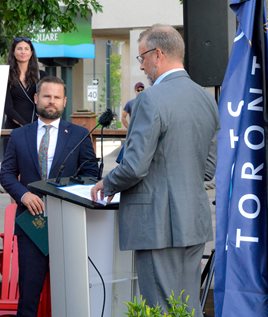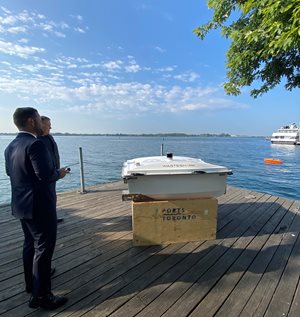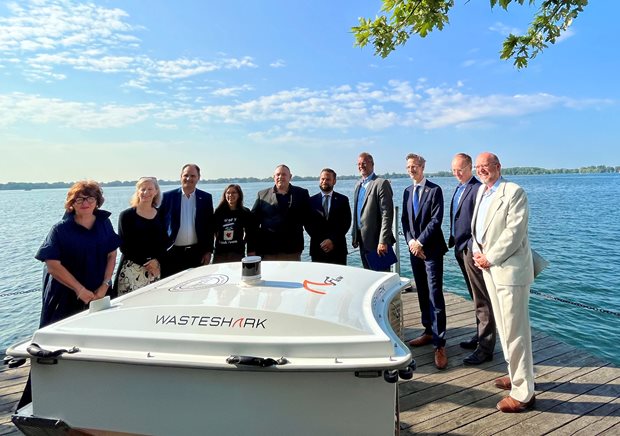PortsToronto Launches Canadian Debut of WasteShark Aquadrone
Toronto (August 9, 2023) – PortsToronto, in partnership with RanMarine Technology, today launched a pilot program that saw two WasteShark aquadrones make their Canadian debut in the Toronto Harbour. As part of PortsToronto’s larger Trash Trapping Program, two new WasteSharks, Ebb and Flow, will join PortsToronto’s network of Seabins in capturing floating debris and small plastic pollution from the surface of the water.
This pilot was made possible through a grant initiative supported by the Ministry of Foreign Affairs of the Netherlands, which supports demonstration projects, feasibility studies, or investment preparation projects that contribute to the United Nations’ Sustainable Development Goals (SDGs).
The WasteShark aquadrone is designed to collect floating debris from aquatic environments and operates in a similar fashion to a Roomba-like vacuum in a home. A versatile tool, the WasteShark can operate manually by remote control and can be programmed to operate autonomously along a prescribed route using an online dashboard. With a 180-litre capacity, the robot can collect and remove 1100-lbs of waste daily from the aquatic environment.


PortsToronto was proud today to introduce Ebb and Flow, whose names were chosen through a public contest and vote earlier this year. Based out of the Outer Harbour Marina, Ebb and Flow will troll problem areas for debris collection throughout the Toronto Harbour and waterfront, collecting debris and contributing to important data collection as part of PortsToronto’s research partnership with the University of Toronto Trash Team and their International Trash Trap Network.
Follow along as Ebb and Flow explore the Toronto Harbour this summer and take a bite out of plastic pollution. Learn about the type, amount and sources of the debris they are capturing by following @Sharks_TO on Twitter and Instagram. Join our community and share your sightings with the hashtags #SharksTO and #WasteShark.
.

PortsToronto leadership and partners gather to celebrate the official launch of the WasteShark aquadrones in the Toronto Harbour.
Quotes
“The WasteShark aquadrone is the latest addition to our successful Trash Trapping Program, which has removed hundreds of thousands of pieces of plastic pollution and debris from the Toronto Harbour and Lake Ontario since 2019. These aquadrones offer exciting new capability within our network of trash trapping devices in the Toronto Harbour, allowing a nimble response to floating debris that will complement the Seabins already deployed along the waterfront. We look forward to continuing this important work with program partners, in particular our longstanding research partnership with the University of Toronto Trash Team and the International Trash Trap Network that will ensure these devices contribute to global data collection and waste diversion efforts.”
RJ Steenstra, President and CEO, PortsToronto
“I commend PortsToronto’s Trash Trapping Program for their commitment to removing waste from Lake Ontario. The new WasteShark aquadrones are an innovation that will only add to this success and build on the work the Government of Ontario has done with partners to launch the largest plastic capture initiative of its kind in the Great Lakes. Premier Ford and I look forward to continuing to work with incredible partners to tackle plastic pollution in the Great Lakes.”
David Piccini, Ontario Minister of the Environment, Conservation and Parks
“Let’s hope that these smart sharks will inspire us humans as well to keep our waterways clean.”
Harman Idema, Consul General of the Netherlands
“We are thrilled to welcome these two new WasteSharks to our waterfront! The Seabins are a fantastic tool for removing small litter items, including microplastics, and we are excited to pair them with WasteSharks that are more geared toward larger items – such as plastic bags, plastic bottles, and single-use cups. This new data will complement the trash trap data we currently collect, contributing important information to inform upstream solutions for preventing litter from reaching our waterfront in the first place.
Dr. Chelsea Rochman, U of T Trash Team
“We are delighted to collaborate with the Ministry of Foreign Affairs of the Netherlands, who have played a vital role in enabling us to showcase our state-of-the-art Dutch technology worldwide and introduce WasteSharks for the first time in Canadian waters in Toronto and Halifax. As RanMarine join forces with PortsToronto, our collective mission is to clean, monitor, protect, and restore water quality. We take pride in steering this crucial initiative, leveraging innovation and strategic partnerships, to promote and advance sustainable and thriving aquatic environments and shape a brighter future for our planet.”
Darren Kirby, Head of Global Sales, RanMarine
Fast Facts
- With a 180-litre capacity, each WasteShark can collect and remove 1100-lbs of waste daily from the aquatic environment.
- The WasteShark can operate both manually and autonomously for up to six hours.
- The WasteShark can collect floating debris, small plastic pollution and vegetation from the surface of the water.
- Vegetation can act as a filter, capturing microplastics in the water.
- Researchers estimate that 10,000 metric tonnes of waste enter the Great Lakes each year, much of it plastic.
- A common occurrence in urban waterways, floating debris comes from a variety of sources – including overflowing or windblown trash bins at the water’s edge, storm water runoff and industry.
- Anthropogenic (originating from human activity) debris, and microplastics in particular can harm wildlife and contaminate drinking water, and negatively impact public enjoyment of cherished shared water resources.
- Since 2019, the Trash Trapping Program has removed hundreds of thousands of small pieces of plastic pollution from the Toronto Harbour, moving the needle toward cleaner water in Lake Ontario.
- To view detailed data, results and mitigation strategies identified during the 2022 research season, please consult the U of T Trash Team’s website.
About the PortsToronto Trash Trapping Program
The PortsToronto Trash Trapping Program employs trash trapping technology and solutions-based research to tackle plastic pollution and protect Toronto’s waters for future generations. Since 2019, the program has removed hundreds of thousands of small pieces of plastic pollution from the Toronto Harbour, moving the needle toward cleaner water in Lake Ontario.
The program is led by PortsToronto and the U of T Trash Team, in partnership with the Waterfront Business Improvement Area (WBIA) and the City of Toronto BIA Office Innovation Grant, Nieuport Aviation, the Toronto Zoo, Harbourfront Centre and Toronto and Region Conservation Authority (TRCA). It is part of the Toronto Inner Harbour Floatables Strategy, a collaborative strategy with a mission to reduce plastic pollution and other floating litter in the harbour, and of the International Trash Trapping Network, an initiative led by the U of T Trash Team and Ocean Conservancy, and has influenced the launch of similar trash trapping and data collection programs throughout the Great Lakes and beyond.
About PortsToronto
For more than 100 years PortsToronto has worked with its partners at the federal, provincial and municipal levels to enhance the economic growth of the City of Toronto and the Greater Toronto Area. PortsToronto owns and operates Billy Bishop Toronto City Airport, which welcomed approximately 2.8 million passengers in 2019; the Outer Harbour Marina, one of Canada’s largest freshwater marinas; and, Marine Terminal 52, which provides transportation, distribution, storage and container services to businesses at the Port of Toronto. PortsToronto is committed to fostering strong, healthy and sustainable communities and has invested more than $14 million since 2009 in charitable initiatives and environmental programs that benefit communities along Toronto’s waterfront and beyond. PortsToronto operates in accordance with the Canada Marine Act and is guided by a nine-member board with representation from all three levels of government.
About RanMarine Technology
RanMarine Technology specialises in the design and development of industrial autonomous surface vessels (ASV’s) for ports, harbors and other marine and water environments. Our purpose is to provide sustainable solutions for the preservation and restoration of aquatic environments, through the development and deployment of autonomous aqua drones. Our line of remote controlled, and autonomous vessels efficiently remove surface waste and algae/biomass while monitoring for imbalances in the marine environment. Targeted environments include estuaries, ports, canals, smart cities, inland rivers and lakes.
Our automated solutions offer a 24% to 80% lower cost per liter of trash collected than traditional methods. We have shipped to 19 countries globally and have offices in the USA and headquarters in Rotterdam, The Netherlands.
About The University of Toronto Trash Team
The U of T Trash Team, co-founded in 2017, is a science-based community outreach organization made up of undergraduate and graduate students, postdocs, researchers, local volunteers and staff all working together with a common goal to increase waste literacy in our community while reducing plastic pollution in our ecosystems. Their local projects use research to inform policy and management, and education and community outreach to increase waste literacy, engage the public and implement effective solutions. Their ultimate goal is to inspire an assortment of solutions resulting in the global reduction of waste and healthier habitats for wildlife and people.
– 30 –
Media Contacts:
PortsToronto
Jessica Pellerin
Manager, Media Relations and Public Affairs
PortsToronto
Cell: (647) 298-0585
E-mail: [email protected]
RanMarine Technology
Esther Lokhorst
CXO RanMarine
Cell: +31 (0)641 69 72 68
E-mail: [email protected]